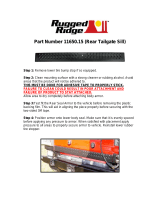APPLICATION INSTRUCTIONS
CLEAN-UP
PRODUCT REMOVAL
PRECAUTIONS AND LIMITATIONS
The Armor LV25 can be applied with a 3/8-1/2” nap roller, or an acetone/solvent resistant HVLP sprayer with Viton seals. For a consistent wet look and low gloss finish, apply two
coats spaced 24 hours apart.
Time Of Day
The Armor LV25 should only be applied in the early evening (around 5 PM or later) when air and surface temperatures are declining, and when the sun is no longer positioned over
the surface.
If applied outside of these limits, the sealer may not achieve adequate film formation and may have excessive air entrapment, bubbles, blushing or hazing.
Surface Preparation
The Armor LV25 should be applied to a completely clean and dry surface. If the surface was cleaned with water or pressure washed prior to application, allow the surface to dry for
at least 24 hours before sealing. While the surface may appear dry and feel dry to touch, water below the surface trapped in the pores can cause the same issues. While pressure
washing the surface is typically sufficient, spot treatment may be necessary for deep or older stains.
The Armor LV25 is designed specifically for use on unsealed concrete and concrete paver surfaces, as well as concrete and concrete pavers previously sealed with a solvent based
acrylic. The Armor LV25 can’t be applied over any other film forming sealer, other than a solvent-based acrylic sealer. It can’t be applied over a water based acrylic, an acrylic
latex, a paint, epoxy, or urethane If the concrete is smooth or trowel finished, and doesn’t quickly and easily absorb water, other surface preparation may be required to open up the
surface pores, such as acid etching or grinding. The Armor LV25 should not be used to seal clay brick, red Chicago pavers, flagstone, slate, or natural stone. If you are looking to
seal clay brick, red Chicago pavers, flagstone, slate, or natural stone, consider instead of the Armor WL550 or the Armor SX5000 WB.
Note About Sealing Pavers:
Please note, the Armor LV25 is not a bonding agent. Do not apply the Armor LV25 over loose sand between paver joints because it will not harden or seal the loose sand. The
Armor LV25 can be applied over the pavers directly, or the pavers and polymeric sand (if the polymeric sand is newly installed, wait 7 days before sealing), but it can’t and should
not be applied over loose sand.
Mixing Color Packs: Do not exceed more than 6 ounces of color per gallon of sealer. Stir color well before adding to sealer, then once added to sealer, stir again, ensuring color is
evenly mixed. Once cured, will cover like a paint—you will be left with an opaque colored finish.
Adding Non-Slip: For best results, apply the Armor non-slip additive with an appropriate hand-held broadcast spreader. When applying the second coat, add the non-slip additive
to the coating using a broadcast spreader, and back roll to encapsulate the non-slip additive.
The applicator is responsible for suitability of application, and the results of the application. We suggest applying to a test area first to verify compatibility, absorption, coverage
rate, and project suitability.
Use Xylene. Dispose of containers in accordance with local and federal regulations.
Dried, cured sealer may be removed with a commercial paint stripper, or by using a diamond grinding method, sandblasting method or similar
mechanical action.
If applying indoors, room should be properly ventilated to allow for solvents to evaporate.
Keep away from open flames. Sealer is flammable and is susceptible to ignition.
Do not apply over floor adhesives, paints, water based coatings, or incompatible sealers.
Coverage rates depend upon many conditions including application method, surface porosity, and applicator.
Please be aware that this product when cured may be slippery when wet. Consider adding Armor Non Slip Additive into the top coat.
Sealer is not resistant to brake fluid, gasoline, and many other similar products.
It is not recommended to thin or cut sealer with any other products.
Sealer will darken the surface in order to enhance dull or faded surfaces.
White spots (blushing) and premature delamination or failure may occur if applied to wet surfaces, surfaces with moisture issues, surfaces
that get wet before the sealer has fully cured, or surfaces that currently have an incompatible sealer or coating down.
If applying sealer to pavers less than one year old, verify with paver manufacturer that pavers are able to be sealed. Sealing before suggest-
ed guidelines can result in coating failure.
Sealer should be applied to concrete that has had 28 days to cure.
Do not apply in the morning or middle of the day to avoid hazing and bubbling.
Store product in an area where the temperature is between 50-80 degrees F, and not in direct sunlight.
It is recommended to wear the proper personal protective equipment when applying this product.
Properly protect and cover any areas not intended or suggested to be sealed during application.
Do not apply over water based acrylics, acrylic latex, paint, or any other film-forming coating other than a solvent based acrylic. Apply to a
test area before sealing to verify compatibility.
This product does not stop hot tire pickup. Hot tire pickup happens when the rubber/asphalt from the hot tire comes off of the tire onto the
surface where the tire comes into contact with. There is physically no way to stop the rubber/asphalt from coming off of the tire.
Plasticizers in rubber mats and rubber based materials may react and bond to cured coating.

















